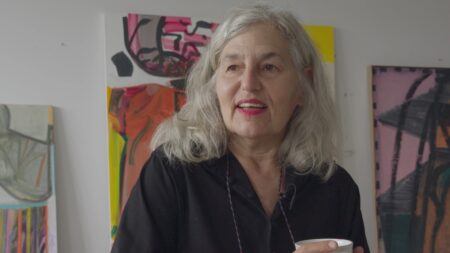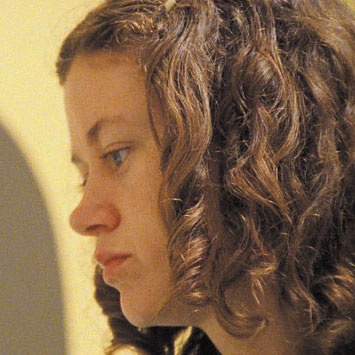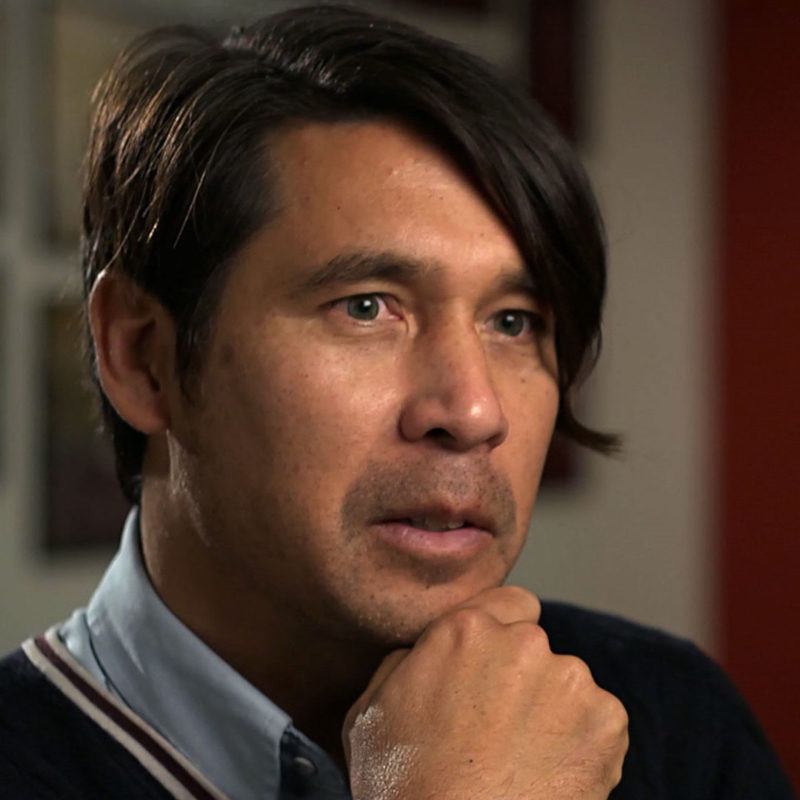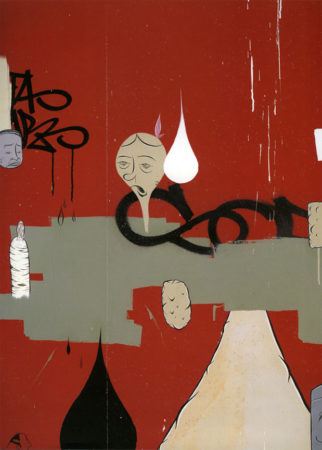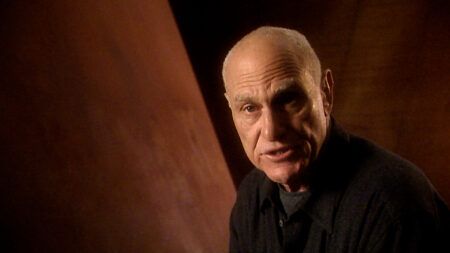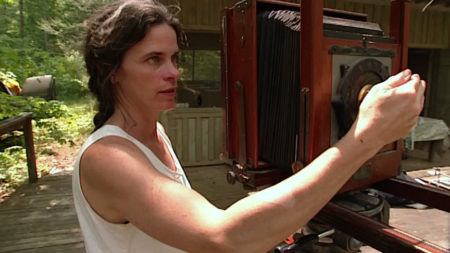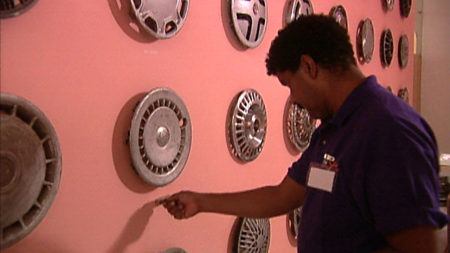Continue playing
(Time remaining: )
Play from beginning
Continue playing "{{ controller.videos[controller.getVideo(controller.currentVideo)].segmentParentTitle}}"
{{controller.videos[controller.getVideo(controller.currentVideo)].title}} has ended.
Barry McGee & Margaret Kilgallen in "Place"
“I like things that are handmade,” says Margaret Kilgallen, referring to the hand-painted signs of San Francisco’s Mission District that influenced her work. “In that they did it themselves—that’s what I find beautiful.” The segment follows Kilgallen as she bikes around the Mission, paints in her studio, visits the San Francisco train yards with artist and husband Barry McGee, and creates a new painting installation at the UCLA/Armand Hammer Museum.
While hand-painting wall sized letters on a ladder, Kilgallen describes her process: “I do spend a lot of time trying to perfect my line work…when you get close up, you can always see the line waver. And I think that’s where the beauty is.”
Barry McGee, who has a passion for graffiti art, says, “I like that process of a thing discarded, then picked up, and intercepted.” In this segment, McGee discloses an urban inspiration for his art. The segment follows McGee and Kilgallen to the local train yards where the artists point out their favorite markings and leave some of their own, contributing to a graphic conversation that spans train cars across the nation.
McGee is also filmed atop a water tower painting one of his signature figures. Traveling to the UCLA/Armand Hammer Museum, the segment follows McGee as he installs a new room-sized work, a two-story mural, as well as a storefront painting looking out on the streets of Los Angeles.
More information and creditsCredits
Created by: Susan Sollins & Susan Dowling. Executive Producer & Curator: Susan Sollins. Executive Producer: Susan Dowling. Series Producer: Eve-Laure Moros Ortega. Associate Producer: Migs Wright. Production Coordinator: Laura Recht. Researcher: Quinn Latimer & Wesley Miller. Director: Catherine Tatge. Editor: Donna Marino. Director of Photography: Bob Elfstrom & Joel Shapiro. Additional Photography: John Chater, Ken Kobland, & Don Lenzer. Sound: Gautam K. Choudhury, Ray Day, Doug Dunderdale, Aldo Ferraris Hierro, Chris Kellett, Ramon Larrabaster, Juan A. Torres, Bill Wander. Assistant Camera: Matthew Gordon, Brian Hwang, Paul Marbury, Glen Piegari, Enrique Puig, & Kipjaz Savoie. Gaffer/Grip: Ned Hallick, Paco Mayo, & Pedro Villalon. Location Manager: Asier Bilbao; Michelle Fernandez Echebarre; & Hilda Frontanes-Suarez, Tropical Visions. Production Assistant: Steve Carrillo, Graham Gangi, Brent Hamilton, Gabriel Monts, Eric Pfriender, Orlando A. Rivera, & Scott Stevens. Animation Stand Photographer: Marcos Levy & City Lights. Assistant Avid Editor: Heather Burak & Matt Prinzig. Assistant to the Director: Rachel Connolly.
Introductory Segment | Director & Writer: Laurie Anderson. Cast: Laurie Anderson. Director of Photography: Joey Forsyte. Gaffer: Peter Boynton, John Roche. Grip/Swing: Kit DiBenedetto, Patrick J. Webb. Make-up: Brooke Hunyady. Props: Heather Dunbar, Ali Goldman, & Zhanna Gurvich. Editor: Melody London. Assistant Editor: John Kim. Tai Chi Music by: Oliver Shanti & Friends.
Creative Consultant: Ed Sherin. Art Design and Direction: Open, New York. Animation, Visual Effects & Compositing: Spontaneous Combustion. On-Line Editor: Don Wyllie & Frame:Runner NYC. Composer: Peter Foley. Music Supervisor: John Yaffé. Sound Editing: Margaret Crimmins, Greg Smith, & Dog Bark Sound. Sound Mix: Tony Volante & Soundtrack, New York. Post-Production Supervisor: Michael Weingrad & Keir Randall.
Artworks courtesy of: Margaret Kilgallen; Sally Mann; Barry McGee; Pepón Osorio; Richard Serra; Bernice Steinbaum Gallery; Deitch Projects; Edwynn Houk Gallery; & Ronald Feldman Fine Arts. Archival footage of Barry McGee courtesy of: Thomas Campbell.
Special Thanks: Anne C. Baker; Alison Beall; City Lights; Silvia Karman Cubina; Susan Delson; Escuela de Artes Plasticas; Goldenberg Family; Russell Hassell; Jenni Holder; Instituto De Cultura Puertorriquena; Bruce Mac Corkindale; The Mann Family; Margarita Moreno; Museo de Arte Contemporaneo de Puerto Rico; Museo de Arte de Puerto Rico; Chris Pullman; Tina Rosario and family; Tamberelli Video; Tropical Visions; UCLA Hammer Museum; Virginia Museum of Fine Arts; Darin Webb
Interns: Maytal Ahrony, Joyce Alcantara, Christina Darcy, Leslie Fritz, Johanna Goldfeld, Susannah Gust, Sage Lehman, Kelly McCoy, Genevieve Mercatante, Jeff Seelbach, & Stacy Wu.
Public Relations: Kelly & Salerno Communications. Legal Counsel: Albert Gottesman.
Major underwriting for Season 1 of Art in the Twenty-First Century is provided by Robert Lehman Foundation, PBS, National Endowment for the Arts, Corporation for Public Broadcasting, Rockefeller Brothers Fund, Agnes Gund and Daniel Shapiro, The Allen Foundation for the Arts, The Broad Art Foundation, The Jon and Mary Shirley Foundation, Bagley Wright Fund, The Rockefeller Foundation, The Andy Warhol Foundation for the Visual Arts, The Horace W. Goldsmith Foundation, and The Foundation-to-Life.
Closed captionsAvailable in English, German, Romanian, Italian, Japanese, Korean, Chinese, Italian
Through the Art21 Translation Project, multilingual audiences from around the globe can contribute translations, making Art21 films more accessible worldwide.
Interested in showing this film in an exhibition or public screening? To license this video please visit Licensing & Reproduction.
Early experiences as a librarian and bookbinder contributed to Margaret Kilgallen’s encyclopedic knowledge of signs, drawn from American folk tradition, printmaking, and letterpress. Painting directly on the wall, Kilgallen created room-size murals that recall a time when personal craft and handmade signs were the dominant aesthetic. Strong, independent women—walking, surfing, fighting, and biking—are featured prominently in the artist’s compositions. Kilgallen had a love of “things that show the evidence of the human hand.” She died in June 2001 in San Francisco, where she lived with her husband, Barry McGee.
Barry McGee’s drawings, paintings, and mixed-media installations take their inspiration from contemporary urban culture, incorporating elements such as empty liquor bottles and spray-paint cans, tagged signs, wrenches, and scrap wood or metal. McGee is also a graffiti artist, working on the streets of America’s cities since the 1980s, where he is known by the tag name “Twist.” He views graffiti as a vital method of communication, one that keeps him in touch with a larger, more diverse audience than can be reached through the traditional spaces of a gallery or museum.
Barry McGee & Margaret Kilgallen
Barry McGee
Margaret Kilgallen
Barry McGee
“The public looks at graffiti and sees garbage and sees ugliness. And I always wonder why they don’t look at the billboards, especially around San Francisco there’s millions everywhere—isn’t that garbage? That’s like mind garbage.”
Margaret Kilgallen
